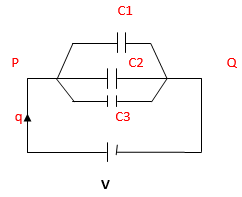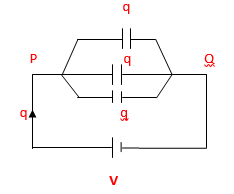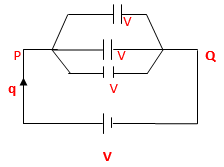Parallel Combination of Capacitors
Description:
Let there are three capacitors (C1, C2 and C3) having capacitance (C1, C2 and C3) are connected in Parallel. Capacitor C1 consists of two plates ( say plate A and B), Capacitor C2 consists of two plates (say plate C and D) whereas Capacitor C3 consists of two plates (say plate E and F).
First Plate each capacitor is connected with point P whereas another plate of each is connected with Q. The two points P and Q are connected with the two terminals of battery so, so the potential difference (V) is created across point P and Q.

Features of parallel combination
Feature 1 − The total charge gets distributed across each capacitor connected in parallel.
As the battery is connected, the positive charges start flowing from positive terminal of battery to point P. If the charge has to move from point P to Q then, From P charge can take either of the three paths to reach Q ( i.e. through C1, C2 or C3). The charge acquired by each capacitor depends on the capacitance of capacitors.
Let the charge acquired by capacitor C1 be q1
charge acquired by capacitor C2 be q2
charge acquired by capacitor C3 be q3
This is how the charges gets distributed across each capacitor.
But, Total charge q = q1 + q2 + q3

Feature 2 − Potential remains the same across all the capacitors and is equal to the potential of battery.
Since first Plate each capacitor is directly connected with positive terminal of battery whereas another plate of each is connected with the negative terminal of the battery so, there will be no potential drop across the capacitors. So, potential across each capacitor remains same and is equal to the potential of the battery.

Feature 3 − In parallel combination, capacitance increases.
We know that in parallel,
q = q1 + q2 + q3
As the potential is same across each capacitor, so, dividing the equation by V we get:
q/v = q1/v + q2/v + q3/v -----(1)
We know that, q = CV
C = q/v
So, equation (1) becomes:
C = C1 + C2 + C3
This gives the relation of capacitance of system with capacitor C1, C2 and C3
If C is the total capacitance of the system, So, this can be called as equivalent capacitance (Cequivalent)
So, Cequivalent = C1 + C2 + C3
To check whether equivalent capacitance increases or decreases in parallel combination. Take a combination of two capacitor, each having capacitance of 2μf and are connected in series.
Using;
Cequivalent = C1 + C2
Putting the capacitance value of each capacitor we get:
Cequivalent = 2 + 2 = 4 μf
So we conclude from above example that capacitance increases in parallel combination.
Capacitance for ‘n’ number of capacitors
If there are ‘n’ number of capacitors in parallel and each having capacitance = Cμf then,
Cequivalent = C1 + C2 + C3 + ..... + Cn
Cequivalent = nC
Comparision between series and parallel combination
| Series Combination | Parallel Combination |
|---|---|
| Same charge is acquired by all the capacitors | The total charge gets distributed across each capacitor |
| Potential is divided across all the capacitors. | Potential remains the same across all the capacitors |
| capacitance decreases. | capacitance increases. |

